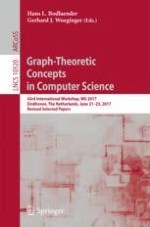2017 | Book
Graph-Theoretic Concepts in Computer Science
43rd International Workshop, WG 2017, Eindhoven, The Netherlands, June 21-23, 2017, Revised Selected Papers
Editors: Hans L. Bodlaender, Gerhard J. Woeginger
Publisher: Springer International Publishing
Book Series : Lecture Notes in Computer Science
